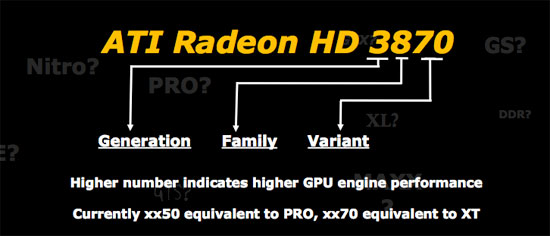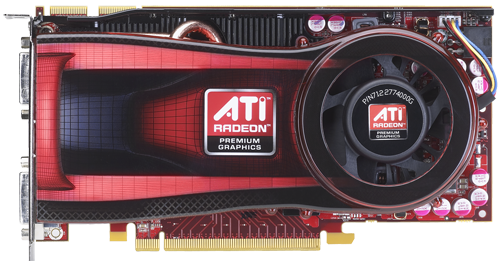Faster Graphics For Lower Prices: ATI Radeon HD 4770
by Derek Wilson on April 28, 2009 5:15 AM EST- Posted in
- GPUs
First things first: the Radeon HD 4770 is faster than existing 4800 series hardware (namely the 4830). Yes, this is by design.
We hate to start another article complaining about naming (there seems to be some sort of pervasive renaissance of poor naming this year), but let's talk about why exactly we are in this situation with a look back at something from our RV670 coverage:

At least it's ironic.
Yes, the problem is born out of AMD's attempt at sensible, appropriate naming. The problem is that AMD seems to want to associate that "family" number with the physical GPU than with the a performance class. This is despite the fact that they generally use increasing numbers for "families" that are generally faster. Thus, the 40nm RV740 needs a new family name, and they can't really choose 49xx presumably (by us) because people would be more upset if they saw a high number and got lower performance than if they saw a lower number and got higher performance. So Radeon HD 4770 it is.

When we brought up our issues with the naming scheme, AMD was quick to respond that naming is one of the most contentious things that go on in bringing a graphics card to market. People get passionate about the issue. Passion is great, but not if it confuses, misleads, or distracts the end user. And that's what a decision like this does. There is no practical reason that this card shouldn't be named 4840 to reflect where it's performance falls. After all, the recently released 4890 is host to quite a few tweaks to the physical layout of the chip and it isn't called the 4970.
At the same time, that trailing zero is doing nothing on all AMD hardware. There is an extra number in there that could allow AMD to shift some things around in their naming scheme to retain all the information they want to reflect about architecture generation, processes revision, performance class and specific performance within that class. If we are going to have a model number system, in order to have real value to both the informed and casual graphics card user it needs to be built to properly represent the underlying hardware AND be strictly related to performance. With this move, AMD joins NVIDIA in taking too many liberties with naming to the detriment of the end user.
Now that that's taken care of, what we have today is a 40nm GPU (the first) paired with 512MB of RAM on a $110 card. The package delivers performance at a level between the 4830 and the 4850. First indications were that this would be a $99 part and the performance we see with this card at the "magic" price would be terrific. It's still not bad at a 10% higher price. AMD had indicated that there should be some $10 mail in rebates available for those who are interested in the extra bonus hassle and upfront cost to get the cash.










88 Comments
View All Comments
balancedthinking - Tuesday, April 28, 2009 - link
http://www.pcgameshardware.de/aid,682645/Test-Ati-...">http://www.pcgameshardware.de/aid,68264...force-98...Zstream - Tuesday, April 28, 2009 - link
It is because Derek wrote the article. As long as he is benchmarking and testing the AMD bashing will continue. Just get used to it.Jamahl - Tuesday, April 28, 2009 - link
The important thing here is there is no attempt by ATI to deceive the public.All the 48xx cards have 256-bit buses, and they also have higher bandwith than the 4770. However, the 4770 has much more in common with a 4870 than it does a 4830 or 4850, namely clock speeds and DDR5. It just so happens that its peformance level drops in at the 4850 mark due to the smaller 128 bit bus and a few less shaders.
If you look at it logically, it's a cut down 4870. 4770 is the best name that could have been chosen for it taking everything into consideration.
coldpower27 - Wednesday, April 29, 2009 - link
I think it kinda makes sense.The first digit explains the generation of technology.
4 = RV7xx Series with DX10.1 Technology. (Current)
3 = RV6xx Series with DX10.0 Refresh Line
2 = R600 Series with DX10 Original Line
The second digit explains where the product Series slots in with regard to everything else...
8 = Performance
7 = Mainstream Refresh
6 = Mainstream
5-3 = Budget...(this should be consolidated)
The Third digit is an isolated variable and explains where it slots within this particular series..
7 = Top Card.
5 = Middle Card.
3 = Low Card.
The Last digit current serves no purpose...
it's a bit more simple I will admit then Nvidia's nomentclature.
With ATI having 7,5,3 for defining top, middle and low of a particular range.
I will try to insert an analgous numbering concept for Nvidia.
Nvidia has GTX+ = 8 GTX = 7 GTS = 6, GT = 5, GS = 3, GSO = 2
I think... very complicated conmpared to 3 SKU's for ATi. At least Nvidia is trying to make some headway into making a unified product line with the GTS 250, GTX 260, GTX 275, GTX 285...
GTX 260 Core 216, should have been GTX 265 for simplicity sake...
flipmode - Tuesday, April 28, 2009 - link
I agree with the author in his criticism of the name chosen for the product.4845 if you want to end odd
4840 if you do not care
Naming these products should not be this hard. What AMD and Nvidia need to be passionate about is helping the buyer make sense of it all.
Also - like the author said - why the hell bother with the 4th digit if it is just going to be -0- all the time. Put that son of a bizzle to work.
flipmode - Tuesday, April 28, 2009 - link
Um yeah, the author seems to think the dual slot cooler is an inconvenience, but I'd LOVE to have a dual slot cooler that pumps the hotness outside of the case for me. Most mobo makers are careful enough about the slot below the PCIe16 slot because, believe it or not, they've thought about the fact that a dual slot graphics card might be put in there.JimmiG - Tuesday, April 28, 2009 - link
Many who buy these lower-end cards have more compact systems, sometimes with m-ATX boards.When I got my 4850 last year I had such a board, meaning a dual slot card would have blocked one of the two PCI slots, and made the last one nearly useless since the PCI card would sit right against the videocard, possibly blocking the fan.
Even though I've got a full ATX board now, the lack of hot air exhaust doesn't bother me. The two 80mm fan+PSU fan take care of getting the hot air out of the case. In fact they move much more hot air than the small GPU fan.
There will probably be variations just like with all other cards so those who want single slot will be able to find one. Prices will also go below $100 in a matter of weeks, IMO.
Griswold - Wednesday, April 29, 2009 - link
This isnt a lower-end card. Its a mid-range card. Low-end is often passive cooled. The single slot cooler on the 3850 and 4850 are misserable for this type of GPU. But i'm sure there will be single slot models of the 4770 as well...flipmode - Tuesday, April 28, 2009 - link
I've got mATX too. AMD needs to focus on providing the best possible cooling and not make compromises for mATX. And when these cards arrive with bad ass coolers that keep the chips cool, the noise down, and the case temps down, it is too bad they get looked on with scorn. The consumer made his/her bed when choosing a motherboard and case. And even still, this card, dual slot and all, will fit in an mATX setup.That's just my feeling. I am thrilled to see high quality coolers attached to a $100 card. That's wonderful!
PrinceGaz - Wednesday, April 29, 2009 - link
I agree. Far from not liking a dual-slot cooler, I love them. Not only do they keep the GPU itself cooler, but they also improve the overall system airflow. Given the choice, I'd always pick a dual-slot cooler over a same priced card with a single-slot cooler.The only possible reason for choosing a single-slot cooler would be if you wanted to use the slot right next to the gfx-card, which means the already inferior single-slot cooler is made even worse because there is now another card sitting millimetres from the GPU fan.